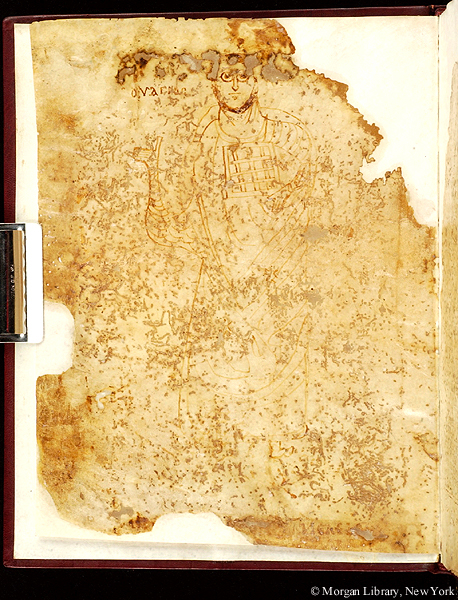
Accession number
MS M.594
Object title
Homily II on the Passion (MS M.594).
Created
Egypt, ca. 822/23-913/14.
Binding
Ancient binding: According to Petersen, upper and lower covers, and half of the back, of leather, over papyrus boards. (Binding catalogued separately as MS M.594A.)
Credit line
Purchased for J. Pierpont Morgan (1837-1913) in 1911.
Description
20 leaves (2 columns, 38-39 lines), bound : vellum, ill. ; 327 x 260 mm
Provenance
Property of the Monastery of Apa Epima of Ps̆ānte at Narmoute in the Fayyūm Province, Egypt; Monastery of Saint Michael (Dayr al-Malāk Mīkhāʼil); found in 1910 near the village of Hamuli, Fayyūm Province, Egypt, at the site of the Monastery of Saint Michael; purchased in Paris in 1911 for J. Pierpont Morgan (1837-1913) from Arthur Sambon, a dealer acting in behalf of a consortium of owners including a certain J. Kalebdian; J.P. Morgan (1867-1943).
Notes
Manuscript of a homily on the Passion, attributed to St. Cyril of Jerusalem (St. Cyril, Bishop of Jerusalem); written and illuminated in Egypt, ca. 822/23-913/14.
Text: Homily II on the Passion.
Colophons: Plimpton 1, fol. 7v: Owner's name in Greek and Coptic: Property of the Monastery of Apa Epima of Psănte ("the acacia grove") at Narmoute (Narmouthis) in the Faiyum; for Ps̆ōnte (Psante) (Greek Akanthōn? "acacia"); 2) Plimpton 1, fol. 7v: Donation (?) or copyists (?) in Coptic: [...] memorializing [...] and Apiu or [...]apiu the priest and his son. (Since this text immediately follows colophon 1, it probably requests prayers for either the donors or the copyists (cf. Depuydt).
Written area ca. 274 x 191 mm. Divisions: Ekthesis, slightly enlarged initial, and paragraphus sign (painted budded diple, budded diple and obelus, or rarely coronis) setting off paragraphs..
Script: Upright (titles right-sloping). 10 lines = ca. 71 mm
Superlineation: Non-standard. Punctuation: Raised reddened dot in conjunction with a space; reddened colon and horizontal space filler at ends of paragraphs. Tremas.
Collation: No remains of signatures; no quire ornaments, monograms, headlines or catchwords.
Scribe: unknown; last letters of name may be apiu. Petersen (1954) suggests there are two copyists.
Decoration: frontispiece, headpiece, paragraphus signs, page numbers, extended letter. Colors: strong reddish orange (Centroid 25), green (chemically altered).
Related fragments: Five fragmentary leaves immediately following fol. 20 (completing the text block) are wanting and are now held at Columbia University as Plimpton 1.
Text: Homily II on the Passion.
Colophons: Plimpton 1, fol. 7v: Owner's name in Greek and Coptic: Property of the Monastery of Apa Epima of Psănte ("the acacia grove") at Narmoute (Narmouthis) in the Faiyum; for Ps̆ōnte (Psante) (Greek Akanthōn? "acacia"); 2) Plimpton 1, fol. 7v: Donation (?) or copyists (?) in Coptic: [...] memorializing [...] and Apiu or [...]apiu the priest and his son. (Since this text immediately follows colophon 1, it probably requests prayers for either the donors or the copyists (cf. Depuydt).
Written area ca. 274 x 191 mm. Divisions: Ekthesis, slightly enlarged initial, and paragraphus sign (painted budded diple, budded diple and obelus, or rarely coronis) setting off paragraphs..
Script: Upright (titles right-sloping). 10 lines = ca. 71 mm
Superlineation: Non-standard. Punctuation: Raised reddened dot in conjunction with a space; reddened colon and horizontal space filler at ends of paragraphs. Tremas.
Collation: No remains of signatures; no quire ornaments, monograms, headlines or catchwords.
Scribe: unknown; last letters of name may be apiu. Petersen (1954) suggests there are two copyists.
Decoration: frontispiece, headpiece, paragraphus signs, page numbers, extended letter. Colors: strong reddish orange (Centroid 25), green (chemically altered).
Related fragments: Five fragmentary leaves immediately following fol. 20 (completing the text block) are wanting and are now held at Columbia University as Plimpton 1.
Language
Coptic, the Sahidic dialect
Resources
Century
Catalog link
Classification
Department
